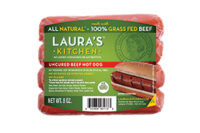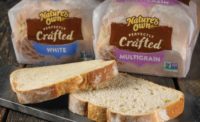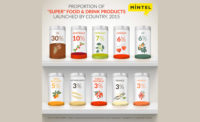Consumers Crave Superfoods
Mintel Global New Products Database (GNPD) reveals that between 2011 and 2015, there was a 202% increase globally in the number of new food and drink products launched containing the terms “superfood,” “superfruit” or “supergrain.”

Mamma Chia, Carlsbad, Calif., says each new Mamma Chia Organic Chia & Greens variety delivers 2500mg of Omega-3s, 4g of complete protein, 7g of fiber, 25% RDA of vitamin A and 95mg of calcium.

The U.S. had the highest proportion of "super" food and drink products launched in 2015.


Superfoods are frequently marketed as the answer to consumers’ health woes and now new research from Mintel highlights the popularity of these nutrient packed foods. Mintel Global New Products Database (GNPD) reveals that between 2011 and 2015, there was a 202% increase globally in the number of new food and drink products launched containing the terms “superfood,” “superfruit” or “supergrain.”
And it seems there is no end to the popularity of these so called wonder foods, as in 2015 alone there was a 36% rise in the number of food and drink products launched globally featuring the terms “superfood,” “superfruit” or “supergrain.” In 2015, the US played host to the most superfood and superdrink launches (30%), followed by Australia (10%), Germany (7%), the UK (6%) and Canada (6%).
The surge in launch activity comes as a result of strong consumer demand for highly nutritious products. Today, more than seven in 10 consumers in France (72%), Germany (71%), Italy (73%) and Spain (72%) agree that health-promoting benefits of natural foods, for instance fruit and vegetables, are preferable to the added benefits of functional foods.
What’s more, Mintel research reveals that the superfood sensation has spread beyond food and drink. Indeed, while 43% of products launched globally 2011-2015 with the words “superfood,” “superfruit” or “supergrain” in the product description were in the food category and 11% fell under the drink category, as many as three in 10 (30%) were found in beauty and personal care, while 12% were in the health and hygiene category and 4% were in the pet category.
“The popularity of ‘super’ products is clear as food and drink manufacturers globally are tapping into a demand for these nutritionally dense ingredients,” observes Stephanie Mattucci, a global food science analyst at Mintel. “But superfoods are not only limited to food and drink as they are regularly appearing in the beauty, health and hygiene and pet food aisles as a result of today’s consumers becoming much more aware of what they are putting into and onto their bodies.”
In particular, the trend towards a wheat-free diet has resulted in a growing number of products containing the “supergrains” ancient grains. While quinoa and buckwheat have both become household names in recent years, it is chia which has seen the biggest rise in usage. Between 2014 and 2015, there was a 70% increase in the percentage of food and drink products launched containing chia, while launches of food and drink products containing teff rose by 31%. Meanwhile, the number of food and drink products containing quinoa rose by 27%.
“Desire for healthier, less refined alternatives to wheat has fueled the rediscovery of ancient grains,” Mattucci adds. “Flavorful and nutrient-dense ancient grains have begun to change the negative perception of some carbohydrates by leveraging their nutritional profile and rich heritage. Ancient grains offer an alternative to wheat but also come bundled with functional and nutritional components, and provide new flavors and textures. They are a great way for free-from products to talk about health.”
Alongside the hype in launch activity, there also is strong consumer interest in ancient grains as 30% of UK pasta consumers say that pasta made with ancient grains, for instance quinoa, is healthier than regular pasta. What’s more, usage of these heritage grains is high, as two in five (41%) US consumers have eaten ancient grain-based cereals.
“While the number of products containing ancient grains has been rising, next we could see the popularity of sprouting ancient grains,” says Mattucci. “The ancient, accidental process of sprouting—where whole grains are soaked and left to germinate—has largely been eliminated by modern processing techniques. There has been a return to this ancient practice, with controlled sprouting practices being introduced, as the nutritive advantage of sprouted grains is being recognized. The ancient grain quinoa is leading the comeback of sprouted grains.”
Pulses, Seeds & Spices
With the United Nations announcing 2016 as “the year of the pulse,” pulses have also been receiving added attention. During the past two years, the number of food and drink products launched globally with green split pea has grown 126%, while food and drink products containing coral lentils has grown 62% and food and drink products containing yellow split peas has increased 21%.
“Pulses can be used to add a range of natural health benefits to food and drink products,” notes Mattucci. “Additionally, healthy pulses are staples in many ethnic cuisines, offering manufacturers a pathway for product innovation for convenience-seeking ethnic food explorers.”
Mintel research reveals that super seeds have also seen an uptick in usage. During the past two years, the number of food and drink products containing chia seeds has risen 70% globally, while launches containing pumpkin seeds has grown 27% and the number of food and drink products containing sunflower seeds has grown 22%.
“Some seeds, including chia and pumpkin seeds, offer complete protein, with all nine essential amino acids in the correct ratios. However, a lot of protein from seeds is incomplete. Blending seeds can help improve the quality of protein,” Mattucci adds.
Going forward, it seems that turmeric, known for its anti-inflammatory benefits and moringa, said to have beauty and anti-aging properties, could be the superfoods to watch.
“Turmeric has potential as an ingredient in supplements and functional food and drink products, particularly within products aimed at the growing senior population,” concludes Mattucci. “Additionally, moringa could be used in anti-aging beauty food products. While currently the ingredient is used in many beauty launches, the leaves are nutritional powerhouses.”
NPD Group: “Fewer Consumers Read Label”
With a vote of support from First Lady Michele Obama, the US Food and Drug Administration (FDA) recently announced its plans to overhaul the Nutrition Facts label on the back of packaged foods. The announcement comes at a time when the percent of US consumers who actually read the Nutrition Facts label is declining, reports The NPD Group, a leading global information company.
A decade ago 15% of consumers said that they do not look at the label and now 24% don’t, according to NPD’s ongoing food consumption research.
“The reasons why more consumers are not looking at the labels are varied, but among the reasons is that the label hasn’t been updated in over 20 years. Additionally, consumers now have many more resources at their fingertips to research nutritional information” says Darren Seifer, NPD food and beverage industry analyst. “The fact that there is a new label and it will be more reflective of consumer interests and how they actually eat may recapture their interest.”
As for those consumers who do read the Nutrition Facts label, calories were for a long time the top item checked on its own, but adults are now checking first for sugars on the label and total calories are now a close second. Following sugars and calories, in rank order of importance, are sodium, total fat, and total carbohydrates, reports NPD Dieting Monitor, which is an ongoing tracker that captures consumers’ dieting behavior and eating intentions.
Originally appeared in the July, 2016 issue of Prepared Foods as Report: Consumers Crave "Superfoods".
Looking for a reprint of this article?
From high-res PDFs to custom plaques, order your copy today!








